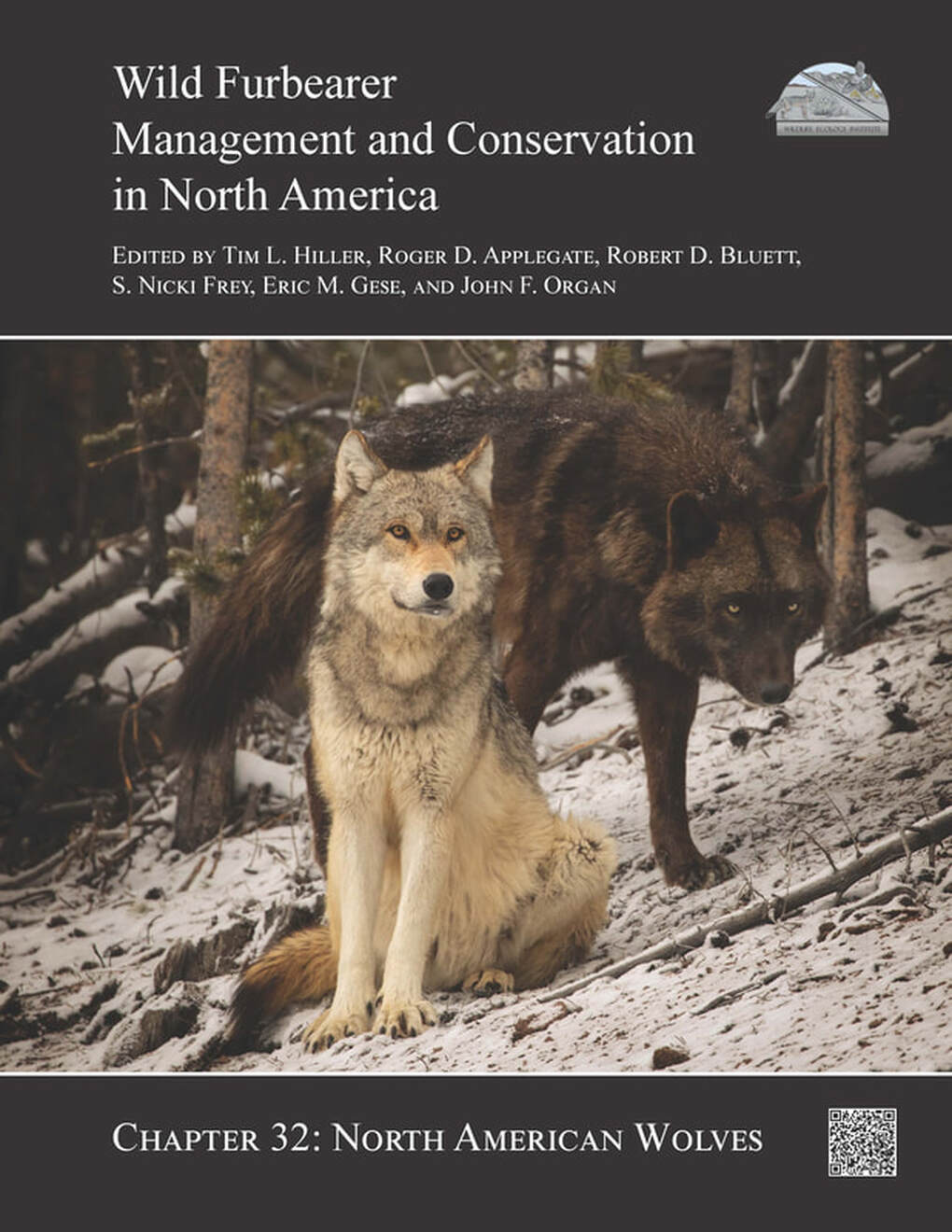For information about this book, including the Table of Contents, click here.
Published 10 August 2023
© 2023 Wildlife Ecology Institute
https://doi.org/10.59438/FYHC8935
© 2023 Wildlife Ecology Institute
https://doi.org/10.59438/FYHC8935
INTRODUCTION
Since publication of the chapter on North American wolves (Carbyn 1987) in Wild Furbearer Management and Conservation in North America (Novak et al. 1987), there has been a substantial expansion in the distribution of wolf populations in North America and Europe, as well as advances in our understanding of wolf ecology. Mech and Boitani (2003) and Paquet and Carbyn (2003) provided important compendiums in the interim. Our objective was to provide a comprehensive update on the ecology, behavior, genetics, and population recovery of North American wolf species, as well as ongoing monitoring and management of existing populations.
Approximately two-thirds of the current distribution of North American wolves occurs in areas of low densities of human populations and almost no presence of livestock (e.g., Alaska, northern Canada). In these regions, wolf abundance is governed primarily by the abundance of their prey, with localized effects of killing by humans. In this chapter, we focus on recent wolf recovery in southern populations with higher population densities of humans, where human-wolf conflicts are relatively common and actively managed. We present historical information and new discoveries, and we reference scientific literature so that readers may find more information. In this chapter, we recognize the gray wolf (Canis lupus), which includes the Mexican gray wolf (Canis lupus baileyi; informally, Mexican wolf) as a subspecies; eastern wolves (Canis sp. cf. lycaon); and red wolves (Canis rufus) as separate species, but we also recognize that some consider these as variations of gray wolves, eastern wolves, or the product of hybridization between gray wolves and coyotes (Canis latrans; Kyle et al. 2006, Chambers et al. 2012, vonHoldt et al. 2016, Hohenlohe et al. 2017, Sacks et al. 2021). We use the general reference of wolf for all 3 species, but use adjectives (gray, eastern, or red) when referring to individual species.
Since publication of the chapter on North American wolves (Carbyn 1987) in Wild Furbearer Management and Conservation in North America (Novak et al. 1987), there has been a substantial expansion in the distribution of wolf populations in North America and Europe, as well as advances in our understanding of wolf ecology. Mech and Boitani (2003) and Paquet and Carbyn (2003) provided important compendiums in the interim. Our objective was to provide a comprehensive update on the ecology, behavior, genetics, and population recovery of North American wolf species, as well as ongoing monitoring and management of existing populations.
Approximately two-thirds of the current distribution of North American wolves occurs in areas of low densities of human populations and almost no presence of livestock (e.g., Alaska, northern Canada). In these regions, wolf abundance is governed primarily by the abundance of their prey, with localized effects of killing by humans. In this chapter, we focus on recent wolf recovery in southern populations with higher population densities of humans, where human-wolf conflicts are relatively common and actively managed. We present historical information and new discoveries, and we reference scientific literature so that readers may find more information. In this chapter, we recognize the gray wolf (Canis lupus), which includes the Mexican gray wolf (Canis lupus baileyi; informally, Mexican wolf) as a subspecies; eastern wolves (Canis sp. cf. lycaon); and red wolves (Canis rufus) as separate species, but we also recognize that some consider these as variations of gray wolves, eastern wolves, or the product of hybridization between gray wolves and coyotes (Canis latrans; Kyle et al. 2006, Chambers et al. 2012, vonHoldt et al. 2016, Hohenlohe et al. 2017, Sacks et al. 2021). We use the general reference of wolf for all 3 species, but use adjectives (gray, eastern, or red) when referring to individual species.
Citation:
Boyd, D. K., D. E. Ausband, H. D. Cluff, J. R. Heffelfinger, J. W. Hinton, B. R. Patterson, and A. P. Wydeven. 2023. North American wolves. Pages 32.1–32.68 in T. L. Hiller, R. D. Applegate, R. D. Bluett, S. N. Frey, E. M. Gese, and J. F. Organ, editors. Wild furbearer management and conservation in North America. Wildlife Ecology Institute, Helena, Montana, USA. https://doi.org/10.59438/FYHC8935
Citation:
Boyd, D. K., D. E. Ausband, H. D. Cluff, J. R. Heffelfinger, J. W. Hinton, B. R. Patterson, and A. P. Wydeven. 2023. North American wolves. Pages 32.1–32.68 in T. L. Hiller, R. D. Applegate, R. D. Bluett, S. N. Frey, E. M. Gese, and J. F. Organ, editors. Wild furbearer management and conservation in North America. Wildlife Ecology Institute, Helena, Montana, USA. https://doi.org/10.59438/FYHC8935
Copyright 2024 Wildlife Ecology Institute



